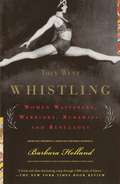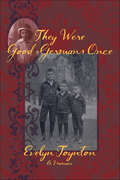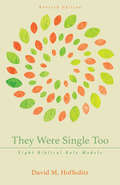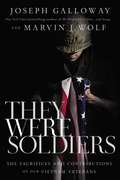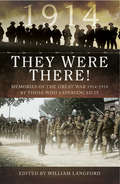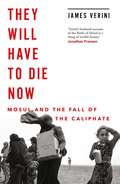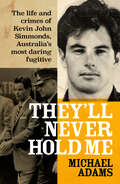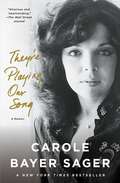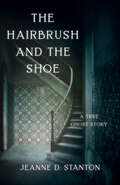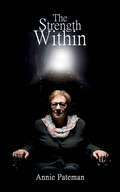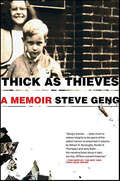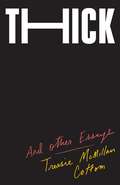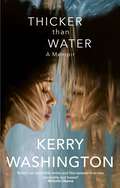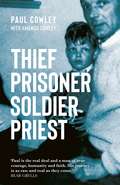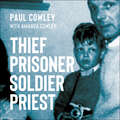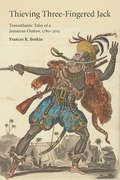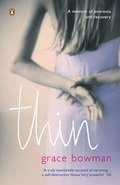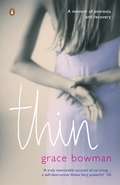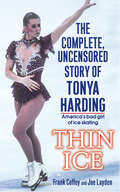- Table View
- List View
They Went Whistling: Women Wayfarers, Warriors, Runaways, and Renegades
by Barbara HollandThroughout history there have been women, endowed with curiosity and abundant spirit, who stepped out of the cave, cast off the shackles of expectation, and struck out for new territory. In this ode to bold, brash, and sometimes just plain dangerous women, Barbara Holland reanimates those rebels who defied convention and challenged authority on a truly grand scale: they traveled the world, commanded pirate ships, spied on the enemy, established foreign countries, scaled 19,000-foot passes, and lobbied to change the Constitution. Some were merry and flamboyant; others depressive and solitary. Some dressed up as men; others cherished their Victorian gowns. Many were ambivalent or absentminded mothers. But every one of them was fearless, eccentric, and fiercely independent. Barbara Holland evokes their energy in this unconventional book that will acquaint you with the likes of Grace O'Malley, a blazing terror of the Irish seas in the 1500s, and surprise you with a fresh perspective on legends like Bonnie Parker of "Bonnie and Clyde" fame. With wit, wisdom, and irreverent flair, They Went Whistling makes a compelling case for the virtue of getting into trouble.
They Were Good Germans Once: My Jewish Émigré Family
by Evelyn Toynton&“This priceless recapturing of darkened history . . . [is] stunningly intelligent and elegantly written . . . Utterly engrossing.&” —Phillip Lopate, author of To Show and to Tell: The Craft of Literary Nonfiction In this moving collection of essays, Evelyn Toynton, &“a wordsmith of the highest order&” traces her family history, from her mother who left Germany as Hitler came to power to her relatives who escaped after suffering persecution and internment at the hands of the Nazis (Library Journal, starred review). Toynton only fully understood her harrowing genealogy as an adult living in New York, where she first came to terms with her connection to other Jews in America. Growing up, her family was German first, retaining the attitudes and the characteristics of the homeland they still loved and longed for, even as they built new lives in America, Israel, and England. Some, like her father, appeared to assimilate easily, while others never lost the feeling that they were living in exile. Powerfully rendered by an acclaimed author, They Were Good Germans Once is a remarkable account of survival, starting over, and the search for meaning and hope in a world forever altered. &“A poignant memoir . . . The author&’s tone is often elegiac. . . . A thoughtful, notable addition to the literature of the Holocaust.&” —Kirkus Reviews &“With Toynton&’s signature intelligence, subtlety and wit, she describes members of her family—deracinated through no fault of their own—in portraits that are by turns surprising, hilarious and heartbreaking.&” —Lynn Freed, author of The Romance of Elsewhere &“[A] tragic, comic, sharply observed memoir.&” —Carole Angier, author of Speak, Silence: In Search of W.G. Sebald
They Were Single Too: Eight Biblical Role Models
by David M. HoffeditzSingleness is not a sin that needs to be redeemed. Yet for many single Christians, the way the church regards them often feels condemning. Living between these truths can be a painful, frustrating experience.By examining eight individuals from Scripture who were single at some point in their adult lives--Paul, Anna, Martha, Jeremiah, Ruth, Joseph, Nehemiah, and John the Baptist--Hoffeditz guides readers through common struggles singles face, such as loneliness and disappointment.Hoffeditz isn't offering a self-help guide, a twelve-step program to recovery, or philosophical musings. They Were Single Too spells out concrete steps for a healthy, God-approved attitude toward unmarried life and how one can truly serve God without a spouse. Brief chapters with questions for reflection allow for either individual or group study.Long used as a resource for singles ministries, this revised edition updates the language of this timeless biblical study and makes it more attractive for today's reader.
They Were Soldiers: The Sacrifices and Contributions of Our Vietnam Veterans
by Marvin J. Wolf Joseph L. GallowayThey Were Soldiers showcases the inspiring true stories of 49 Vietnam veterans who returned home from the "lost war" to enrich America's present and future. In this groundbreaking new book, Joseph L. Galloway, distinguished war correspondent and New York Times bestselling author of We Were Soldiers Once . . . and Young, and Marvin J. Wolf, Vietnam veteran and award-winning author, reveal the private lives of those who returned from Vietnam to make astonishing contributions in science, medicine, business, and other arenas, and change America for the better.For decades, the soldiers who served in Vietnam were shunned by the American public and ignored by their government. Many were vilified or had their struggles to reintegrate into society magnified by distorted depictions of veterans as dangerous or demented. Even today, Vietnam veterans have not received their due. Until now. These profiles are touching and courageous, and often startling.They include veterans both known and unknown, including:Frederick Wallace (&“Fred&”) Smith, CEO and founder of FedExMarshall Carter, chairman of the New York Stock ExchangeJustice Eileen Moore, appellate judge who also serves as a mentor in California's Combat Veterans CourtRichard Armitage, former deputy secretary of state under Colin PowellGuion &“Guy&” Bluford Jr., first African American in space Engrossing, moving, and eye-opening, They Were Soldiers is a magnificent tribute that gives long overdue honor and recognition to the soldiers of this "forgotten generation."
They Were There in 1914: Memories of the Great War 1914–1918 by Those Who Experienced It
by William LangfordIn September 1938, as Chamberlain was having discussions with Herr Hitler, and managing to secure 'Peace in our Time', a weekly magazine called I WAS THERE hit the newsagents and booksellers. Twenty years had elapsed since the Great War ended and in that period hundreds of books on the subject had been written by those who took part. It was from these published sources that extracts were taken from the personal stories of soldiers, sailors and airmen who had experienced the 'war to end all wars' first-hand. The magazine I WAS THERE proved popular with the public and came only came to an end as the Second World War broke out.This rework in book form They Were There has allowed these stories of 1914 to be aired once more covering exciting accounts from Mons to the Christmas Truce, 1914, and to the German naval bombardment of the East Coast of England in December of that year. We are confident that many will agree, these stories are well worth ressurecting and presenting in book form to readers of the 21st Century 100 years after they were first told.
They Will Have to Die Now: Mosul and the Fall of the Caliphate
by James VeriniThe battle is for a city. The war is for history. In autumn 2016, Iraqi forces began operations to recapture Mosul from the Islamic State. Millennia-old, Mosul was a birthplace of Western culture but also infamous for its cruelty, from the Assyrians to Saddam Hussein. Through the eyes of soldiers and families and jihadis, award-winning reporter James Verini chronicles the combat that followed. Among the most devastating urban conflicts since World War II, the battle for Mosul was both archaic and modern. Troops and jihadis fought house by house, block by block, matching bullet for bullet, while co-ordinating their movements on WhatsApp and uploading execution videos. Verini describes how this viciously contested patch of earth came to represent a war for the soul of a country, for its history and its future.
They Worked Together
by Anna ProkosTells the stories of some great teams: Edmund Hillary and Tenzing Norgay, Helen Keller and Anne Sullivan, and Meriwether Lewis, William Clark, and Sacagawea.
They'll Never Hold Me: The life and crimes of Kevin John Simmonds, Australia's most daring fugitive
by Michael AdamsIn 1959, Australians thrilled to every move made by a new criminal underdog, a Ned Kelly for the rock'n'roll era.Kevin John Simmonds was a charismatic crook whose brazen crime spree had scored him a lengthy prison sentence. But as he was led from court, he boasted, 'They'll never hold me.'Two months later, Simmo made good on his promise, staging a daring escape from Long Bay Gaol. When his bid for freedom took a deadly turn, legendary Detective Ray 'the Gunner' Kelly took charge of the search, putting the fugitive in the crosshairs of the biggest armed manhunt in Australian history.They'll Never Hold Me is the true story of an antihero with a code of honour who captured the public's hearts and minds even as he enraged the cops and the establishment. Brilliantly researched and written by Michael Adams, of the Forgotten Australia podcast, this never-before-told tale takes us beyond the public adventures that made Simmo into Public Enemy No. 1 to reveal the haunting tragedies he was trying to outrun - and the terrible fate that even he might not escape.
They'll Never Hold Me: The life and crimes of Kevin John Simmonds, Australia's most daring fugitive
by Michael AdamsIn 1959, Australians thrilled to every move made by a new criminal underdog, a Ned Kelly for the rock'n'roll era.Kevin John Simmonds was a charismatic crook whose brazen crime spree had scored him a lengthy prison sentence. But as he was led from court, he boasted, 'They'll never hold me.'Two months later, Simmo made good on his promise, staging a daring escape from Long Bay Gaol. When his bid for freedom took a deadly turn, legendary Detective Ray 'the Gunner' Kelly took charge of the search, putting the fugitive in the crosshairs of the biggest armed manhunt in Australian history.They'll Never Hold Me is the true story of an antihero with a code of honour who captured the public's hearts and minds even as he enraged the cops and the establishment. Brilliantly researched and written by Michael Adams, of the Forgotten Australia podcast, this never-before-told tale takes us beyond the public adventures that made Simmo into Public Enemy No. 1 to reveal the haunting tragedies he was trying to outrun - and the terrible fate that even he might not escape.
They're Playing Our Song: A Memoir
by Carole Bayer SagerA New York Times bestseller from Grammy and Academy Award–winning songwriter Carole Bayer Sager shares &“a delightful and funny tell-all crammed with famous names and famous songs&” (Steve Martin), from her fascinating (and sometimes calamitous) relationships to her collaborations with the greatest composers and musical artists of our time.For five decades, Carole Bayer Sager has been among the most admired and successful songwriters at work, responsible for her lyrical contributions to some of the most popular songs in the English language, including &“Nobody Does It Better,&” &“A Groovy Kind of Love,&” &“Don&’t Cry Out Loud,&” and the theme from the movie Arthur, &“The Best That You Can Do&” (about getting caught between the moon and New York City). She has collaborated with (and written for) a dizzying number of stars, including Peter Allen, Ray Charles, Celine Dion, Bob Dylan, Neil Diamond, Clint Eastwood, Aretha Franklin, Whitney Houston, Michael Jackson, Carole King, Melissa Manchester, Reba McEntire, Bette Midler, Dolly Parton, Carly Simon, Frank Sinatra, and Barbra Streisand. But while her professional life was filled with success and fascinating people, her personal life was far more difficult and dramatic. In this memoir that &“reads like a candid conversation over a bottle of Mersault on a breezy Bel Air night&” (Vanity Fair), Carole Bayer Sager tells the surprisingly frank and darkly humorous story of a woman whose sometimes crippling fears and devastating relationships inspired many of the songs she would ultimately write. &“This exceptionally candid memoir&” (Los Angeles Times) will fascinate anyone interested in the craft of songwriting and the joy of collaboration, but They&’re Playing Our Song is also a deeply personal account of how love and heartbreak made her the woman, and the writer, she is. &“Carole Bayer Sager is simply the finest….and this book is one of the best, most lasting songs she has ever written&” (Carly Simon).
The Hairbrush and the Shoe: A True Ghost Story
by Jeanne D. StantonWhen a workman is pushed and hissed at by something invisible on the stairs of her family’s 150-year-old townhouse, Jeanne Stanton must confront the possibility that a ghost inhabits. She proceeds in the way any former Harvard Business School case writer would: she embarks upon a rigorous search for proof of the ghost’s existence and identity, exploring the literature and lore of ghosts; the practices of mediums, psychics, and “ghost busters;” and the various attempts that have been made over the decades to verify ghostly sounds and sights through scientific methods. After visits to a psychic provide insights but not proof, Stanton enters the equally mysterious realms of physics and neurology, hoping science has answers. Notables encountered during her research efforts include Henry James, Arthur Conan Doyle, Oliver Sacks, and Sigmund Freud, the latter a colleague of her home’s original owner. Wry and witty, Stanton takes time out to laugh at her own futile attempts at ghost detection—spending a sleepless night in an allegedly haunted bedroom, creeping along the edges of rooms in search of cold spots—along the way. Determined to get to the bottom of the ghost business, Stanton wavers between skepticism and belief, searching for definitive evidence—and almost failing to find it. Almost.
The Strength Within
by Annie PatemanDecember 1979, Annie was three months pregnant with her second child and in excruciating pain. She couldn't walk, couldn't stand, couldn't sleep. In just a year, Annie had gone from being an active young woman to almost entirely incapacitated.Going from one doctor to another, after 18 months, Annie finally had a diagnosis - it was a malignant Ewing's tumour the size of a tennis ball on her knee. Cancer. Almost in the same breath, Annie was told she would have to have her leg amputated above the knee and then told the baby wouldn't survive the surgery…they both defied the odds. She was 26 years old and 26 weeks pregnant.Annie has demonstrated amazing courage sharing her story and overcoming adversity, further setbacks and living life to the full, encouraging the reader to believe there is light at the end of the tunnel, even when you can't see it.
Thi. Ja. Ranganathan
by Pazha AthiyamanMonograph in Tamil on Thi. Ja. Ranganathan [Thingalur Jagathrakshaka Ranganathan (1901-74)] who was an eminent Tamil writer and Journalist. This book details his biography, his contributions to Tamil Literature in the form of short stories, Essays, Translations, Children's literature, etc. and includes a glossary of his writings.
Thick As Thieves: A Brother, a Sister—a True Story of Two Turbulent Lives
by Steve GengA memoir about two siblings who loved each other (sometimes); the thrill of the shoplift, the power of the written word, the agony of addiction, and the joy of someone who understands you and still stays trueSteve Geng—thief, addict, committed member of Manhattan's criminal semi-elite—was a rhapsody in blue, all on his own. Women had a tendency to crack his head open. His sister? Also unusual: Veronica Geng wrote brilliantly eccentric pieces for The New Yorker, hung with rock stars and Pulitzer Prize winners, threw the occasional typewriter, fled intimacy. They were parallel universes, but when they converged, it was . . . memorable. Spanning decades of unresolved personal drama and rebellion, Steve Geng's memoir, Thick as Thieves, is the story of their lives, the bond between them, and all the things they shared. Raw, real, and funny, Geng follows his unique family history from Philadelphia to Paris, Greenwich Village to Riker's Island. We meet lovable, often treacherous characters (B.J. the Queen of Crime, Tina Brown). We hear the rants of the Geng's father, the Colonel; the malicious invective of publishing; the patter of hardened criminals. This is a memoir that will lift your spirit, kick you in the shins, and help you remember the person who understood you the most. Geng has made a lot of mistakes in his life. Thick as Thieves may just make up for them.
Thick: And Other Essays
by Tressie McMillan CottomIn eight highly praised treatises on beauty, media, money, and more, Tressie McMillan Cottom—award-winning professor and acclaimed author of Lower Ed—is unapologetically “thick”: deemed “thick where I should have been thin, more where I should have been less,” McMillan Cottom refuses to shy away from blending the personal with the political, from bringing her full self and voice to the fore of her analytical work. Thick “transforms narrative moments into analyses of whiteness, black misogyny, and status-signaling as means of survival for black women” (Los Angeles Review of Books) with “writing that is as deft as it is amusing” (Darnell L. Moore). <p><p> This “transgressive, provocative, and brilliant” (Roxane Gay) collection cements McMillan Cottom’s position as a public thinker capable of shedding new light on what the “personal essay” can do. She turns her chosen form into a showcase for her critical dexterity, investigating everything from Saturday Night Live, LinkedIn, and BBQ Becky to sexual violence, infant mortality, and Trump rallies. <p> Collected in an indispensable volume that speaks to the everywoman and the erudite alike, these unforgettable essays never fail to be “painfully honest and gloriously affirming” and hold “a mirror to your soul and to that of America” (Dorothy Roberts).
Thicker than Water
by Kerry WashingtonAward-winning actor, director, producer, and activist Kerry Washington shares the deeply moving journey of her life so far, and the bravely intimate story of discovering her truth. While on a drive in Los Angeles, on a seemingly average afternoon, Kerry Washington received a text message that would send her on a life-changing journey of self-discovery. In an instant, her very identity was torn apart, with everything she thought she knew about herself thrown into question.In Thicker than Water, Washington gives readers an intimate view into both her public and private worlds - as a mother, daughter, wife, artist, advocate, and trailblazer. Chronicling her upbringing and life's journey thus far, she reveals how she faced a series of challenges and setbacks, effectively hid childhood traumas, met extraordinary mentors, managed to grow her career and crossed the threshold into stardom and political advocacy, ultimately discovering her truest self and, with it a deeper sense of belonging. Throughout this profoundly moving and beautifully written memoir, Washington attempts to answer the questions so many have struggled with: Who am I? What is my truest and most authentic self? How do I find a deeper sense of connection and belonging? With grace and honesty, she inspires readers to search for - and find - themselves.
Thicker than Water
by Kerry WashingtonAward-winning actor, director, producer, and activist Kerry Washington shares the deeply moving journey of her life so far, and the bravely intimate story of discovering her truth. While on a drive in Los Angeles, on a seemingly average afternoon, Kerry Washington received a text message that would send her on a life-changing journey of self-discovery. In an instant, her very identity was torn apart, with everything she thought she knew about herself thrown into question.In Thicker than Water, Washington gives readers an intimate view into both her public and private worlds - as a mother, daughter, wife, artist, advocate, and trailblazer. Chronicling her upbringing and life's journey thus far, she reveals how she faced a series of challenges and setbacks, effectively hid childhood traumas, met extraordinary mentors, managed to grow her career and crossed the threshold into stardom and political advocacy, ultimately discovering her truest self and, with it a deeper sense of belonging. Throughout this profoundly moving and beautifully written memoir, Washington attempts to answer the questions so many have struggled with: Who am I? What is my truest and most authentic self? How do I find a deeper sense of connection and belonging? With grace and honesty, she inspires readers to search for - and find - themselves.
Thicker than Water: A Memoir
by Kerry WashingtonAward-winning actor, director, producer, and activist Kerry Washington shares the deeply moving journey of her life so far, and the "beautiful" story of discovering her truth in this instant New York Times bestseller (Oprah Winfrey). While on a drive in Los Angeles, on a seemingly average afternoon, Kerry Washington received a text message that would send her on a life-changing journey of self-discovery. In an instant, her very identity was torn apart, with everything she thought she knew about herself thrown into question. In Thicker than Water, Washington gives readers an intimate view into both her public and private worlds—as a mother, daughter, wife, artist, advocate, and trailblazer. Chronicling her upbringing and life&’s journey thus far, she reveals how she faced a series of challenges and setbacks, effectively hid childhood traumas, met extraordinary mentors, managed to grow her career, and crossed the threshold into stardom and political advocacy, ultimately discovering her truest self and, with it, a deeper sense of belonging. Throughout this profoundly moving and beautifully written memoir, Washington attempts to answer the questions so many have struggled with: Who am I? What is my truest and most authentic self? How do I find a deeper sense of connection and belonging? With grace and honesty, she inspires readers to search for—and find—themselves.
Thief Prisoner Soldier Priest
by Paul CowleyPaul Cowley grew up in Manchester amid the chaotic world of his alcoholic parents. His early exposure to heavy drinking, explosive arguments and the unnerving aggression of his father led him into homelessness and crime. By seventeen he was behind bars. Years later, following a career in the army which 'made a man of him' yet ultimately failed to give him direction and purpose, Paul's search for meaning resulted in an unexpected encounter with God that changed his life for ever.This remarkable and touching account of his early years, from thief to prisoner, soldier and, eventually, priest, should inspire anyone who feels their life is out of control. It is, by turns, a dramatic, traumatic and comic story, yet one that stands as a testament to how God offers hope to all who have the courage to respond.
Thief Prisoner Soldier Priest
by Paul CowleyPaul Cowley grew up in Manchester amid the chaotic world of his alcoholic parents. His early exposure to heavy drinking, explosive arguments and the unnerving aggression of his father led him into homelessness and crime. By seventeen he was behind bars. Years later, following a career in the army which 'made a man of him' yet ultimately failed to give him direction and purpose, Paul's search for meaning resulted in an unexpected encounter with God that changed his life for ever.This remarkable and touching account of his early years, from thief to prisoner, soldier and, eventually, priest, should inspire anyone who feels their life is out of control. It is, by turns, a dramatic, traumatic and comic story, yet one that stands as a testament to how God offers hope to all who have the courage to respond.
Thief Prisoner Soldier Priest
by Paul CowleyAn inspiring and raw autobiography from the Reverend Paul Cowley MBE.Paul Cowley grew up in Manchester amid the chaotic world of his alcoholic parents. His early exposure to heavy drinking, explosive arguments and the unnerving aggression of his father led him into homelessness and crime. By seventeen he was behind bars. Years later, following a career in the army which 'made a man of him' yet ultimately failed to give him direction and purpose, Paul's search for meaning resulted in an unexpected encounter with God that changed his life for ever.This remarkable and touching account of his early years, from thief to prisoner, soldier and, eventually, priest, should inspire anyone who feels their life is out of control. It is, by turns, a dramatic, traumatic and comic story, yet one that stands as a testament to how God offers hope to all who have the courage to respond.(P) 2022 Hodder & Stoughton Limited
Thieving Three-Fingered Jack: Transatlantic Tales of a Jamaican Outlaw, 1780-2015
by Frances R. BotkinThe fugitive slave known as “Three-Fingered Jack” terrorized colonial Jamaica from 1780 until vanquished by Maroons, self-emancipated Afro-Jamaicans bound by treaty to police the island for runaways and rebels. A thief and a killer, Jack was also a freedom fighter who sabotaged the colonial machine until his grisly death at its behest. Narratives about his exploits shed light on the problems of black rebellion and solutions administered by the colonial state, creating an occasion to consider counter-narratives about its methods of divide and conquer. For more than two centuries, writers, performers, and storytellers in England, Jamaica, and the United States have “thieved" Three Fingered Jack's riveting tale, defining black agency through and against representations of his resistance.Frances R. Botkin offers a literary and cultural history that explores the persistence of stories about this black rebel, his contributions to constructions of black masculinity in the Atlantic world, and his legacies in Jamaican and United States popular culture.
Thin
by Grace BowmanGrace Bowman lived a perfectly ordinary life as a pretty, popular teenager until one day, aged eighteen, she went on a diet and didn't stop. Then couldn't stop. Her weight plummeted to less than six stone (84 pounds). Starving herself had become an addiction.
Thin
by Grace BowmanBright, popular, pretty and successful, Grace Bowman had the world at her feet. So what drove her to starve herself nearly to death at the age of 18? And what, more importantly, made her stop? A grippingly honest account of life with anorexia nervosa, A Shape of My Own is Grace's hearbreaking, shocking and, finally, inspirational memoir. An extraordinary story, it is also a common one - is there a woman in the western world who has a normal relationship with food? A compulsive read, essential for anyone hoping to understand more about eating disorders and overcoming addiction.
Thin Ice: The Complete, Uncensored Story of Tonya Harding
by Joe Layden Frank CoffeyIt’s Impossible to Forget Tonya Harding. She will be forever remembered as a tough-talking, hard-living athlete who would do anything to become an Olympic Gold Medalist. But was Tonya Harding a misunderstood girl from the wrong side of the tracks? Did her raw talent and burning ambition trip her up? How far was she willing to go to beat her greatest rival, Nancy Kerrigan? Award-winning sportswriter Joe Layden and bestselling author Frank Coffey go past the bright lights of the rink to find the truth behind Harding’s public image. Despite a nightmare childhood of poverty and abuse, a troubled marriage, and a disastrous divorce, Harding became one of her generation’s greatest figure skaters. But did she reach her sport’s ultimate goal fair and square? How deeply was she involved in the stunning attack on Nancy Kerrigan? How did she really feel about her rival? Throughout the controversy that derailed her career, Harding held her head high and stayed true to herself. Fierce, undaunted, uncensored—this is the true story of Tonya Harding. Includes 10 revealing photographs!
